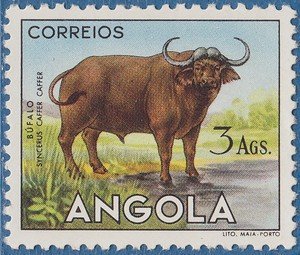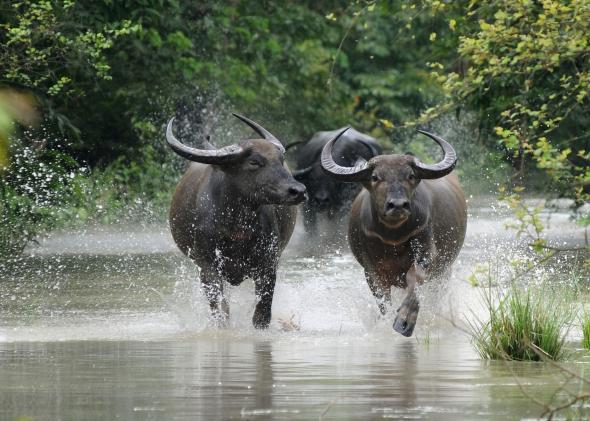Stamp: African Buffalo (Syncerus caffer) (Angola 1953)
African Buffalo (Syncerus caffer) (Angola 1953)
15 August (Angola ) within release Animals goes into circulation Stamp African Buffalo (Syncerus caffer) face value 3 Angolan angolar
| Stamp African Buffalo (Syncerus caffer) in catalogues | |
|---|---|
| Michel: | Mi:AO 379 |
| Stamp Number: | Sn:AO 373 |
Stamp is horizontal format.
Also in the issue Animals:
- Stamp - Leopard (Panthera pardus) face value 5;
- Stamp - Giant Sable Antelope (Hippotragus niger variani) face value 10;
- Stamp - African Elephant (Loxodonta africana) face value 20;
- Stamp - Common Eland (Taurotragus oryx) face value 30;
- Stamp - Nile Crocodile (Crocodylus niloticus) face value 40;
- Stamp - Impala (Aepyceros melampus) face value 50;
- Stamp - Mountain Zebra (Equus zebra) face value 1;
- Stamp - Sitatunga or Marshbuck (Tragelaphus spekii) face value 1.50;
- Stamp - Black or Hook-lipped Rhinoceros (Diceros bicornis) face value 2;
- Stamp - Gemsbok (Oryx gazella) face value 2.30;
- Stamp - Lion (Panthera leo) face value 2.50;
- Stamp - African Buffalo (Syncerus caffer) face value 3;
- Stamp - Springbok (Antidorcas marsupialis) face value 3.50;
- Stamp - Blue Wildebeest (Connochaetes taurinus) face value 4;
- Stamp - Red Hartebeest (Alcelaphus buselaphus caama) face value 5;
- Stamp - Desert Warthog (Phacochoerus aethiopicus) face value 7;
- Stamp - Ellipsen Waterbuck (Kobus ellipsiprymnus) face value 10;
- Stamp - Common Hippo (Hippopotamus amphibius) face value 12.50;
- Stamp - Greater Kudu (Tragelaphus strepsiceros) face value 15;
- Stamp - Giraffe (Giraffa camelopardalis) face value 20;
Stamp African Buffalo (Syncerus caffer) it reflects the thematic directions:
Mammals are any vertebrates within the class Mammalia (/məˈmeɪli.ə/ from Latin mamma "breast"), a clade of endothermic amniotes distinguished from reptiles (including birds) by the possession of a neocortex (a region of the brain), hair, three middle ear bones and mammary glands. All female mammals nurse their young with milk, secreted from the mammary glands. Mammals include the largest animals on the planet, the great whales. The basic body type is a terrestrial quadruped, but some mammals are adapted for life at sea, in the air, in trees, underground or on two legs. The largest group of mammals, the placentals, have a placenta, which enables the feeding of the fetus during gestation. Mammals range in size from the 30–40 mm (1.2–1.6 in) bumblebee bat to the 30-meter (98 ft) blue whale. With the exception of the five species of monotreme (egg-laying mammals), all modern mammals give birth to live young. Most mammals, including the six most species-rich orders, belong to the placental group. The largest orders are the rodents, bats and Soricomorpha (shrews and allies). The next three biggest orders, depending on the biological classification scheme used, are the Primates (apes and monkeys), the Cetartiodactyla (whales and even-toed ungulates), and the Carnivora (cats, dogs, seals, and allies).
Animals are multicellular, eukaryotic organisms of the kingdom Animalia (also called Metazoa). All animals are motile, meaning they can move spontaneously and independently, at some point in their lives. Their body plan eventually becomes fixed as they develop, although some undergo a process of metamorphosis later on in their lives. All animals are heterotrophs: they must ingest other organisms or their products for sustenance.
Bubalina is a subtribe of wild cattle that includes the various species of true buffalo. Species include the African buffalo, the anoas, and the wild water buffalo (including the domesticated variant water buffalo). Buffaloes can be found naturally in sub-Saharan Africa, South Asia and Southeast Asia, and domestic and feral populations have been introduced to Europe, the Americas, and Australia.In addition to the living species, bubalinans have an extensive fossil record where remains have been found in much of Afro-Eurasia



